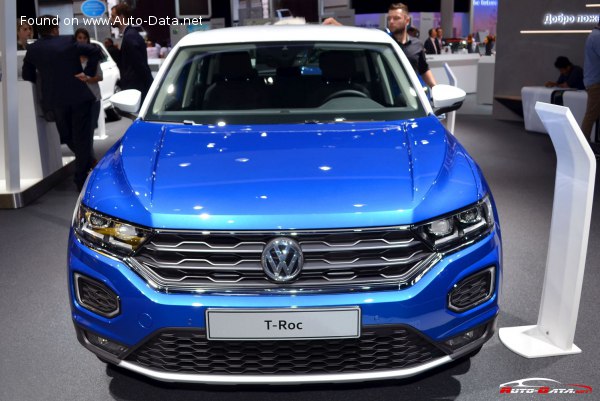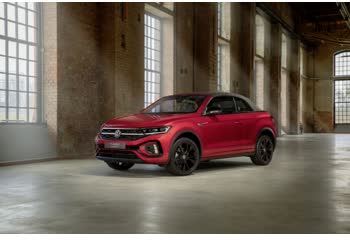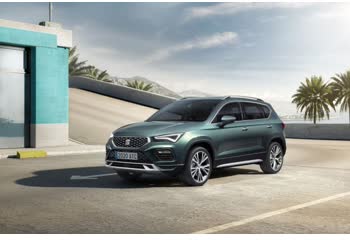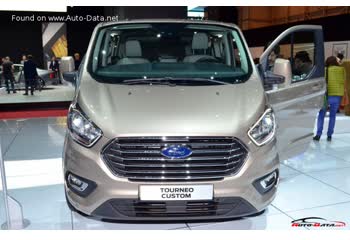Everything you need to know about specifications and performance - Volkswagen T-Roc T-Roc 2020 - 2.0 TDI SCR (150 Hp) DSG

Overview:
What is the engine capacity of a Volkswagen T-Roc 2020?
The engine capacity of the Volkswagen T-Roc 2020 is 1968 cm.
Volkswagen T-Roc 2020 How many horsepower?
The engine power of the Volkswagen T-Roc 2020 is 150 Hp @ 3500 rpm..
What is the Volkswagen T-Roc 2020 engine?
Volkswagen T-Roc 2020 engine is DFFA. (Click to see other cars using the same engine)
How much gasoline does a Volkswagen T-Roc 2020 consume?
The Volkswagen T-Roc 2020 consumes 4.5-4.7 liters of gasoline per 100 km
General:
Brand: Volkswagen
Model: T-Roc
Generation: T-Roc
Modification (Engine): 2.0 TDI SCR (150 Hp) DSG
Start of production: 2020
End of production: October, 2021
Powertrain Architecture: Internal Combustion Engine
Body type: Sports Utility Vehicle (SUV)
Seats: 5
Doors: 5
Engine:
Engine systems: Start & Stop System
Power: 150 hp @ 3500 rpm.
Power per litre: 76.2 hp/l
Torque: 340 nm @ 1750-3000 rpm.
Engine Model/Code: DFFA
Engine displacement: 1968 cm
Number of cylinders: 4
Engine configuration: Inline
Number of valves per cylinder: 4
Fuel injection system: Diesel Commonrail
Engine aspiration: Turbocharger, Intercooler
Engine oil capacity: 4.7 l
Engine layout: Front, Transverse
Performance:
Fuel Type: Diesel
Fuel consumption (economy) - urban: 5.2-5.4 l/100 km
Fuel consumption (economy) - extra urban: 4.1-4.3 l/100 km
Combined fuel consumption (WLTP): 4.9 l/100 km
Fuel consumption (economy) - combined (NEDC): 4.5-4.7 l/100 km
Fuel consumption at Low speed (WLTP): 6.6 l/100 km
Fuel consumption at Medium speed (WLTP): 4.6 l/100 km
Fuel consumption at high speed (WLTP): 4.1 l/100 km
Fuel consumption at very high speed (WLTP): 5.1 l/100 km
Fuel consumption (economy) - urban (NEDC): 5.2-5.4 l/100 km
Fuel consumption (economy) - extra urban (NEDC): 4.1-4.3 l/100 km
Fuel consumption (economy) - combined: 4.5-4.7 l/100 km
Emission standard: Euro 6d-ISC-Fcm
Acceleration 0 - 100 km/h: 8.8 sec
Acceleration 0 - 62 mph: 8.8 sec
Maximum speed: 205 km/h
Weight-to-power ratio: 9.2 kg/Hp, 108.9 Hp/tonne
Weight-to-torque ratio: 4.1 kg/Nm, 246.7 Nm/tonne
Acceleration 0 - 60 mph: 8.4 sec
Space:
Kerb Weight: 1378 kg
Max. weight: 1960 kg
Max. roof load: 75 kg
Max load: 582 kg
Trunk (boot) space - maximum: 1290 l
Trunk (boot) space - minimum: 445 l
Permitted trailer load with brakes (12%): 1600 kg
Fuel tank capacity: 50 l
Permitted trailer load without brakes: 720 kg
Permitted towbar download: 80 kg
Permitted trailer load with brakes (8%): 1800 kg
dimensions:
Length: 4234 mm
Width: 1819 mm
Height: 1573 mm
wheelbase: 2590 mm
Width including mirrors: 1992 mm
Front track: 1538-1546 mm
Rear (Back) track: 1533-1541 mm
Minimum turning circle (turning diameter): 11.1 m
Approach angle: 16.2°
Departure angle: 18.9°
Powertrain, Suspension and Brakes:
Drivetrain Architecture: The Internal combustion Engine (ICE) drives the front wheels of the vehicle.
Drive wheel: Front wheel drive
Number of gears and type of gearbox: 7 gears, automatic transmission DSG
Front brakes: Ventilated discs
Rear brakes: Disc
Assisting systems: ABS (Anti-lock braking system)
Steering type: Steering rack and pinion
Power steering: Electric Steering
Tires size: 215/55 R17; 215/50 R18
Wheel rims size: 7J x 17; 7J x 18
Front suspension: Independent type McPherson
Rear suspension: Torsion
See also

Last generation.
Its production began in 2022 until Now

Same engine. (DFFA).
Its production began in 2020 until Now

Same production year and almost the same engine capacity.
Its production began in 2020 until 2023
Write a comment